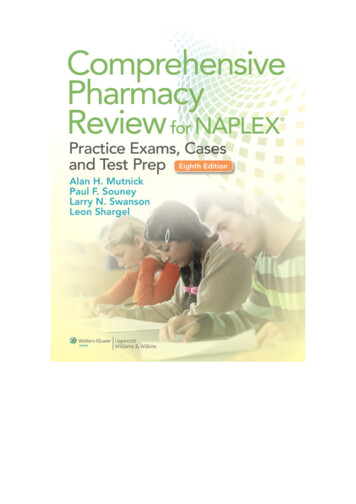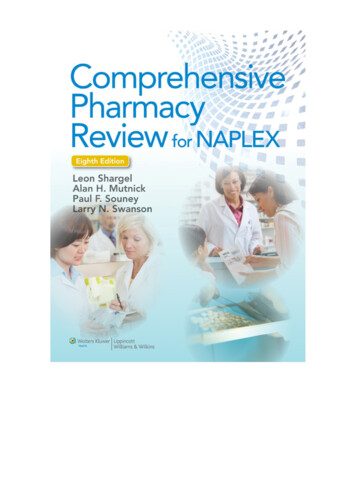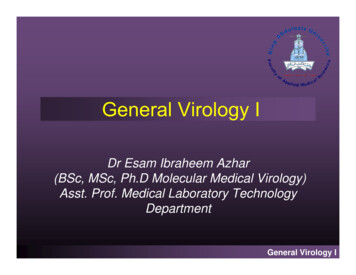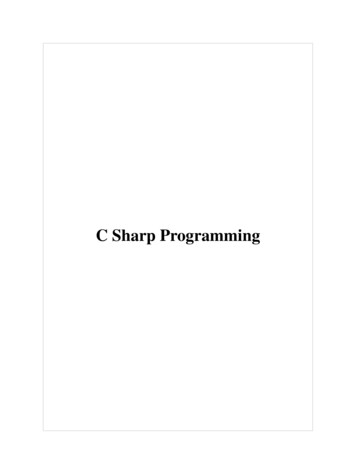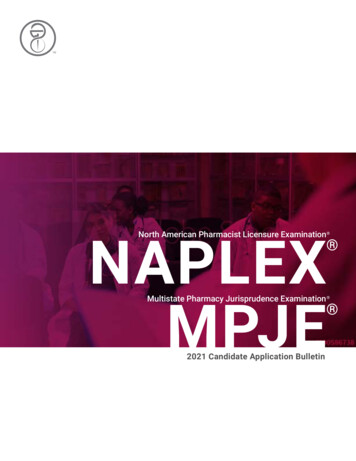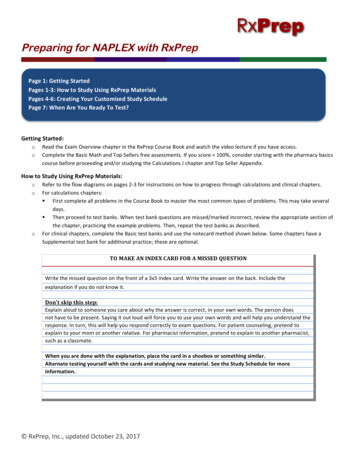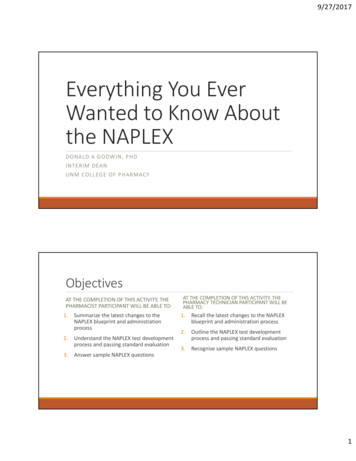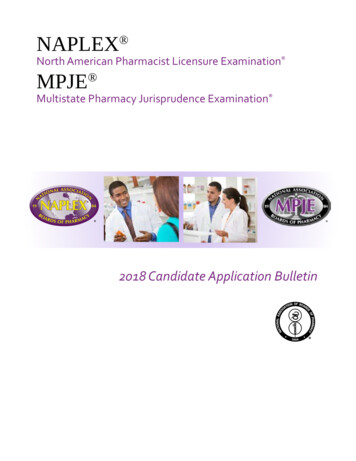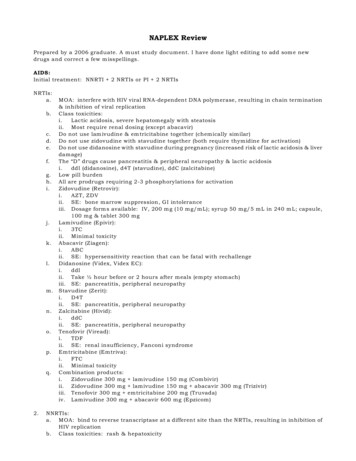
Transcription
NAPLEX ReviewPrepared by a 2006 graduate. A must study document. I have done light editing to add som e newdrugs and correct a few misspellings.AIDS:Initial treatm ent: NNRTI 2 NRTIs or PI 2 : interfere with HIV viral RNA-dependent DNA polym erase, resulting in chain termination& inhibition of viral replicationClass toxicities:i.Lactic acidosis, severe hepatom egaly with steatosisii. Most require renal dosing (except abacavir)Do not use lam ivudine & emtricitabine together (chemically sim ilar)Do not use zidovudine with stavudine together (both require thym idine for activation)Do not use didanosine with stavudine during pregnancy (increased risk of lactic acidosis & liverdam age)The “D” drugs cause pancreatitis & peripheral neuropathy & lactic acidosisi.ddI (didanosine), d4T (stavudine), ddC (zalcitabine)Low pill burdenAll are prodrugs requiring 2-3 phosphorylations for activationZidovudine (Retrovir):i.AZT, ZDVii. SE: bone marrow suppression, GI intoleranceiii. Dosage forms available: IV, 200 m g (10 m g/m L); syrup 50 m g/5 m L in 240 m L; capsule,100 m g & tablet 300 m gLam ivudine (Epivir):i.3TCii. Minim al toxicityAbacavir (Ziagen):i.ABCii. SE: hypersensitivity reaction that can be fatal with rechallengeDidanosine (Videx, Videx EC):i.ddIii. Take ½ hour before or 2 hours after m eals (em pty stom ach)iii. SE: pancreatitis, peripheral neuropathyStavudine (Zerit):i.D4Tii. SE: pancreatitis, peripheral neuropathyZalcitabine (Hivid):i.ddCii. SE: pancreatitis, peripheral neuropathyTenofovir (Viread):i.TDFii. SE: renal insufficiency, Fanconi syndrom eEm tricitabine (Em triva):i.FTCii. Minim al toxicityCom bination products:i.Zidovudine 300 m g lam ivudine 150 m g (Com bivir)ii. Zidovudine 300 m g lam ivudine 150 m g abacavir 300 m g (Trizivir)iii. Tenofovir 300 mg emtricitabine 200 mg (Truvada)iv. Lam ivudine 300 m g abacavir 600 m g (Epzicom )NNRTIs:a. MOA: bind to reverse transcriptase at a different site than the NRTIs, resulting in inhibition ofHIV replicationb. Class toxicities: rash & hepatoxicity
c.d.e.f.g.h.3.All should be dosed for hepatic im pairm entMost are affected by food (except efavirenz)Efavirenz is CI in pregnancyEfavirenz (Sustiva):i.EFVii. Take on an empty stomachiii. SE: CNS side effect; false cannabinoid testNevirapine (Viram une):i.NVPii. Autoinduceriii. SE: rash, sym ptom atic hepatitis, including fatal hepatic necrosisDelavirdine (Rescriptor):i.DLVii. SE: rash, increased LFTsPIs:a. MOA: inhibit protease, which then prevents the cleavage of HIV polyproteins & subsequentlyinduces the formation of im m ature noninfectious viral particlesb. All should be dosed for hepatic im pairm entc.Most should be taken with food (except am prenavir & indinavir)d. Amprenavir & fosam prenavir are chemically sim ilar- avoid com binatione.Atazanavir & indinavir require norm al acid levels in stomach for absorptionf.Ritonavir is the most potentg. Lopinavir/ritonavir, ritonavir, & saquinavir gel caps require refrigerationh. Class toxicities: lipodystrophy, hyperglycem ia, hyperlipidem ia, hypertriglyceridem ia, bleedingin hem ophiliace, osteonecrosis & avascular neocrosis of the hips, osteopenia & osteoporosisi.All are CYP3A4 inhibitorsj.Lopinavir ritonavir (Kaletra):i.SE: GI intoleranceii. Refrigerate caps stable until date on label; stable for 2 m onths at room temperatureiii. Can cause hyperglycem iak. Atazanavir (Reyataz):i.ATVii. SE: increased indirect hyperbilirubinemia, prolonged PR intervall.Fosam prenavir (Lexiva):i.f-APVii. SE: rashiii. Sulfonam ideiv. Oral solution contains propylene glycolm . Am prenavir (Agenerase):i.APVii. SE: rashiii. Sulfonam ideiv. Avoid high fat mealn. Saquinavir:i.SQV-hard gel cap (HGC)- (Invirase):(1) SE: GI intolerance(2) Room temperatureii. SQV- soft gel cap (SGC)- (Fortovase):(1) SE: GI intolerance(2) Refrigerated caps stable until date on label; stable for 3 m onths at room temperatureiii. HGC & SGC are not bioequivalent & should not be interchangedo. Nelfinavir (Viracept):i.NFVii. SE: diarrheaiii. Needs 500 kCal of food for absorption; take after eatingp. Ritonavir (Norvir)i.RTVii. SE: GI intolerance
q.iii. Refrigerated caps stable for 1 m onth at room tem pIndinavir (Crixivan):i.IDVii. SE: nephrolithiases- drink at least 48 oz. daily to preventiii. Take on an empty stomach4.Fusion inhibitors:a. MOA: binds to gp41 on HIV surface, which inhibits HIV binding to CD4 cellb. Enfuvirtide (Fuzeon)i.T20ii. Salvage regim ensiii. Reconstituted form should be stored in the refrigerator- stable for 24 hours5.Those available as suspensions: Nevirapine6.Those available as a syrup or oral solution: Epivir, Ziagen, Videx, Kaletra, Agenerase, Viracept,Norvir7.Post-exposure Prophylaxis (PEP):a. Start therapy within 1-2 hours of exposureb. Length of therapy is 4 weeksc.Treatment options:i.AZT 200 mg po Q8h or 300 m g po Q12h AND 3TC(lam ivudine) 150 mg po Q12hii. AZT 200 mg po Q8h or 300 m g po Q12 3TC 150 m g po Q12h Indinavir 800 mg Q8h(1) OR Nelfinvir 750 mg po Q8h or 1250 mg Q12h8.PCP treatm ent:a. A protozoan, but may be more closely related to fungib. Treat when CD4 cells fall below 200c.DOC: trim ethoprim -sulfam ethoxazole (Bactrim DS) DS po QDd. Alternatives:i.TMP dapsoneii. Atovaquone (Mepron)iii. Pentamidine (NebuPent; Pentam-300)(1) Comes as injection & powder for nebulizationiv. Clindam ycin prim aquinev. Trim etrexate (NeuTrexin) folinic acide.Treatm ent for PCP also covers prophylaxis for: toxoplasm osis9.Macobacterium avium com plex (MAC):a. Treat when CD4 cells fall below 50/m m 3b. DOC is azithromycin 1200 mg po Q week10. CMV: Cytom egalovirusa. Ganciclovir (Cytovene, Vitrasert):i.Use: treatment of CMV retinitis in im m unocom prom ised individuals, including patientswith AIDSii. CI: ANC 500/m m 3 or PLT 25,000/m m 3iii. Dosage forms:(1) Capsule (Cytovene)(2) Im plant, intravitreal (Vitrasert)- 4.5 m g released gradually over 5-8 m onths(3) Injection, powder for reconstitution(a) Should be prepared in a vertical flow hood(b) Reconstitute powder with sterile water NOT bacteriostatic water because parabensm ay cause precipitationAlzheim er’s Disease:1. Donepezil (Aricept):a. Cholinesterase inhibitor
b.c.d.M OA: reversibly & noncom petitively inhibits centrally active acetylcholinesterase, the enzymeresponsible for hydrolysis of acetylcholineAvailable dosage form s: tablets, ODTMax dose: 10 mg QD2.Galantam ine (Razadyne, Razadyne ER, Rem inyl-old nam e):a. Acetylcholinesterase inhibitorb. Max dose:i.IR tablet or solution: 24 mg/day (in 2 divided doses)ii. ER capsule: 24 mg/day3.Mem antine (Nam enda):a. Low affinity, non-competitive, voltage dependent NMDA receptor antagonistb. Neuroprotectivec.Less cognitive decline & im proves cognition in im paired patientsd. After depolarization, Nam enda leaves the site & allows sodium & calcium entry into the celle.Behaves like magnesiumf.Approved for moderate to severe Alzheim er’s Disease4.Rivastigm ine (Exelon):a. Acetylcholinesterase inhibitor (central)b. M OA: increases acetylcholine in the CNS through reversible inhibition of its hydrolysis bycholinesterasec.SE: GI upset (titrate slowly to avoid)d. Dosage forms: capsules & solutionAnem ia:Folic acid deficiency would also be called: m acrocytic anem ia or increased m ean corpuscular volume5. Macrocytic (large cell):a. Megaloblastic:i.Vitam in B 1 2 deficiency(1) Lack of intrinsic factor results in pernicious anem iaii. Folic acid deficiency dec Hct, Hgb, RBC, inc MCH; Norm ochrom ic, norm ocyticb. Aplastic anem iac.Anem ia of chronic disease6.Hypochrom ic (low hem oglobin content), m icrocytic (sm all cell):a. Iron deficiencyi.Inc TIBC, dec MCV, MCH, MCHC, Hgbb. Genetic anom alies: Sickle cell anem ia, thalassem ia7.Treatment:a. Darbepoetin Alpha (Aranesp):i.Recom binant hum an erythropoietinii. Caution in patients with HTN or with a hx of seizures(1) Can cause hypo- or hypertensioniii. Available as an injectionb. Epoetin Alpha (Epogen, Procrit):i.Colony stim ulating factorii. Onset of action: several daysiii. Peak effect: 2-3 weeksiv. SQ 1-3X per weekv.SE: HTNAntidotes:1. Acetaminophen overdose:a. Antidote: Acetylcysteine (Mucom yst, Acetadote):i.MOA: thought to reverse APAP toxicity by providing substrate for conjugation with the toxicm etabolites
ii.Dose: oral- 140 mg/Kg followed by 17 doses of 70 m g/Kg Q4h; repeat dose if em esis occurswithin 1 hour of adm inistration2.Albuterol overdose:a. Antidote: propranolol or beta blocker3.Anticholinergic overdose:a. Antidote: Physostigm ine (Antilirium ):i.Do not use if solution is cloudy or dark brown4.Arsenic overdose:a. Antidote: Succim er (Chem et) or dim ercaprol (British anti-lewisite, BAL in oil)5.Benzodiazepine overdose:a. Antidote: flumazenil (Rom azicon)b. â-blocker overdose: beta-stim ulant (Isoproterenol) and glucagon (GlucaGen)6.CCB overdose:a. Antidote: calcium chloride 10% or glucagon (GlucaGen)7.Carbam ates overdose:a. Antidote: atropine8.Coumadin overdose:a. Antidote: Vitam in K 1 or phytonadione (M ephyton, AquaM EPHYTON); fresh frozen plasmab. Dosage forms available for phytonadione: injection & tablet9.Digoxin overdose:a. Antidote: digoxin im m une antibody fragment (Digibind, DigiFab)10. Ethylene glycol (Antifreeze) overdose:a. Antidote: ethyl alcohol; fomepizole (Antizol); pyridoxine (Am inoxin-OTC); sodium bicarbonate11. Heparin overdose:a. Antidote: protam ine sulfate12. Iron overdose:a. Antidote: deferoxam ine (Desferal)b. Antidote: Polyethylene glycol (high m olecular weight)c.Lethal dose of iron is 180-300 m g/Kg13. Isoniazid overdose:a. Antidote: pyridoxine (Vitam in B 6 )14. Lead overdose:a. Antidotes:i.Succim er (Chem et)ii. Dim ercaprol; also called British anti-lewisite (only for lead encephalopathy)iii. Calcium disodium EDTA (calcium disodium versenate)15. Leucovorin:a. Antidote for folic acid antagonists (m ethotrexate, trim ethoprim, pyrim etham ine)b. W ater soluble vitam in16. Magnesium overdose:a. Death due to muscle relaxation (includes heart failure)b. Antidote: calcium17. Methanol or Ethylene glycol overdose:
a.b.Antidote: Ethanol 10%Antidote: Fom epizole (Antizol)i.AKA: 4-methylpyrazole or 4-MPii. MOA: com petitively inhibits alcohol dehydrogenase, an enzym e which catalyzes them etabolism of ethanol, ethylene glycol, & m ethanol to their toxic metabolitesiii. ?Decreases m etabolism of m ethanol (prevents m etabolism )18. Methem oglobinem ia overdose:a. Antidote: methylene blue19. Opioid overdose:a. Antidote: Naloxone (Narcan)i.MOA: opioid antagonist that com petes at all three CNS opioid receptors (m u, kappa, delta)b. Antidote: Nalm efene (Revex)20. Organophosphates overdose:a. Antidote: atropine or pralidoxim e (Protopam )21. Salicylate overdose:a. Antidote: sodium bicarbonate22. TCAs overdose:a. Antidote: sodium bicarbonate23. Type Ia antiarrhythm ics overdose:a. Antidote: sodium bicarbonate24. Vecuronium overdose: and other nondepolarizing neurom uscular blockersa. Antidote: edrophonium (Enlon, Reversol)Asthm a:1. Drugs available for nebulization:a. Budesonide 0.25 & 0.5 mg (Pulmicort Respules )i.Shake well before usingii. Use with jet nebulizer connected to an air com pressoriii. Adm inister with a m outhpiece or facem askiv. Do not use with an ultrasonic nebulizerv. Do not mix with other medicationsvi. Rinse mouth after useb. Cromolyn (Intal )i.Mast cell stabilizerii. Use: adjunct in the prophylaxis of allergic disorders, including asthm a; prevention ofexercise-induced bronchospasm(1) Nasal: for prevention & treatm ent of seasonal & perennial allergic rhinitisc.Albuterold. Ipratropiume.Ipratropium & Albuterol2.Drugs available as M DI:a. Beclom ethasone HFA 40 mcg/puff & 80 m cg/puff (QVAR )b. Flunisolide 250 mcg/puff (Aerobid )c.Fluticasone 44, 110, 220 mcg/puff (Flovent )d. Cromolyn (Intal )e.Nedocrom il (Tilade )f.Albuterol (Proventil , Ventolin )g. Pirbuterol (Maxair Autohaler )h. Ipratropium (Atrovent )i.Ipratropium & Albuterol (Com bivent )
3.Drugs available as turbuhaler:a. Budesonide 200 mcg/inhalation (Pulm icort Respules)i.Inhaler should be shaken well im m ediately prior to use4.Drugs available for dry powder inhalation (DPI):a. Fluticasone (Flovent Rotadisk )b. Fluticasone-salm eterol (Advair Diskus )c.Form oterol (Foradil Aerolizer )d. Salm eterol (Servent Diskus )i.Stable for 6 weeks after removing foilii. 1 inhalation BID5.Drugs available as M DI/spacer:a. Triam cinolone 100 mcg/puff (Azm acort )6.Class of drugs to use to prevent a child allergic to pollen from having an asthm a attack- could useantihistam ines, cromolyn or inhaled corticosteroids7.A patient would m onitor their asthma from hom e with a peak flow m eter which measures the FEV 1a. Goal: 80% of personal bestb. Green zone (80-100% ), yellow zone (50-79% ), & red zone ( 50% )8.Montelukast (Singulair):a. MOA: selective leukotriene receptor antagonist that inhibits the cysteinyl leukotriene receptorb. Use: asthm a & allergiesi.NOT for COPDc.Dosing;i.6-23 m onths: 4 m g oral granulesii. 2-5 years: 4 m g chewable tablet or oral granulesiii. 6-14 years: 5 mg chewable tabletiv. 15 years: 10 mg tabletv. Take in eveningd. Granules must be used within 15 m inutes of opening9.Zafirlukast (Accolate):a. MOA: selectively & com petitive leukotriene-receptor antagonist of leukotriene D4 & E4b. Use: prophylaxis & chronic treatm ent of asthm a in adults & children 5 years oldc.Dose: 20 mg BIDd. Administer 1 hour before or 2 hours after m ealse.Monitor: LFTsf.Extensively hepatically metabolized via CYP2C9g. Tablets only10. Theophylline:a. 0.80 Aminophylline x 0.8 Theophyllineb. SE:i.15-25 mcg/m L: GI upset, N/V/D, nervousness, headache, insom nia, agitation, dizziness,m uscle cram p, trem orii. 25-35 mcg/mL: tachycardia, occasional PVCiii. 35 mcg/m L: ventricular tachycardia, frequent PVC, seizurec.Theophylline erythromycinà increased levels of theophyllined. DI with cim etidine11. A patient who has had too much albuterol could
NAPLEX Review Prepared by a 2006 graduate. A must study document. I have done light editing to add some new drugs and correct a few misspellings. AIDS: Initial treatment: NNRTI 2 NRTIs or PI 2 NRTIs NRTIs: a. MOA: interf ere w ith HIV viral RNA-dep enden t DNA pol ymerase, resu lting in chain term ination & inhibition of viral replication b. Class toxicities: i. Lactic acidosis, severe .

